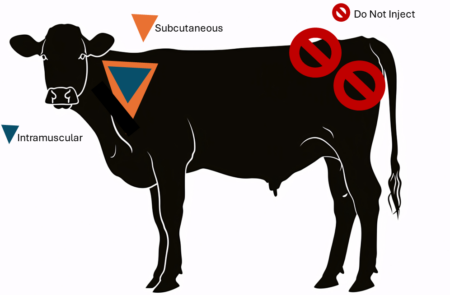

Dr. Lew Strickland
Associate Professor and Extension Livestock Veterinarian
Department of Animal Science
P: 865-974-3150
We visited this topic last year when there were concerns over the announcement on social media that producers were being required to vaccinate their cattle with mRNA vaccine. First, as you are well aware, producers are not required to vaccinate their livestock period, much less with an mRNA vaccine. Next, it is your decision, based on consulting with your veterinarian, what and/or if to even vaccinate at all. It is a health-based decision on the risk/benefit ratio of the diseases present in your area.
What Is the Purpose of a Vaccine?
A requested presentation that I give is Vaccination 101. In this talk I explain that an antigen is something foreign to the body ex, virus, bacteria, parasite. When one of these antigens are introduced to the immune system, the system makes antibodies. An animal can be ‘naturally’ exposed to a pathogen, but it takes time for the system to make antibodies, so the animal must bear the illness that goes along with that infection. However, a vaccine can be given to ‘trick’ the immune system to produce antibodies ahead of exposure and illness. These antibodies then can respond much quicker Think of it like a bounty hunter. That hunter is looking for that image that is on the wanted poster. The immune system works the same way. The system has ‘learned the antigen and is ready to attack that antigen whenever it is present.
Why Didn’t the Vaccine Work?
I often receive calls or hear in producer meetings ‘well, I gave that vaccine Doc, but animals still got sick.’ One think I would like to make clear, vaccines are not 100% no doubt about it makes your animal ironclad. There are multiple factors that come into play on the effectiveness of a vaccine. Was the vaccine stored properly? Was the vaccine managed properly chute side? What was the timing of the vaccine in the life stage of the targeted animal? If a vaccine was given too early in a calf’s life (< 4 weeks), maternal antibodies will render the vaccine useless. Some vaccines require that you vaccinate the dam at certain stages of gestation to provide protection. A vaccine simply reduces the clinical signs associated with a disease; it does not completely prevent it.
Types Of Vaccines
Modified live (MLV) vaccines contain a weakened or attenuated form of a live virus (antigen). Because the virus has been altered, it will closely mimic a true infection. Once the vaccine is administered, the virus will replicate within the animal’s system and create the opportunity for an immune response through the production of antibodies. These antibodies then respond to fight infection if exposed to the natural virus later. A MLV vaccine will typically come packaged as two separate bottles that require mixing. I typically recommend a MLV in a herd that has constant new additions or a stocker type operation. It is important to know the pregnancy status of your herd as a MLV can cause abortions in females that have never had a MLV previously.
Killed vaccines contain an inactivated, or killed, antigen that is incapable of replicating in the animal’s system. Because the killed virus does not have that opportunity to replicate, killed vaccines usually require a booster dose. The killed vaccine requires more viral antigen, or pieces of the virus, to get enough immune system recognition after administration, and is prepared with an adjuvant to create an immune response. Typically, killed vaccines are packaged as a single bottle. I recommend a killed vaccine in a herd that is closed, and the pregnancy status is unknown as killed vaccines are very safe in pregnant cows.
mRNA Vaccines
mRNA vaccines are a relatively new type of vaccine, relative in that the vaccine has been researched for some time now. An example of an mRNA technology vaccine is the Sequivity® vaccine approved for use in swine. This vaccine contains a small portion of genetic material from the pathogen that causes disease. After injection, the cells in the muscle pick up the mRNA, make the protein, and display it on the cell’s surface. The immune system sees the protein and learns how to make antibodies to respond against the pathogen and reduce clinical signs of the disease.. Think of this as being similar to a carpenter reading blueprints to build a house. Once the instructions have been carried out by the builder, he is done. It is the same with mRNA.
A second concern from the public is that the genetic makeup of the animal is changed with an mRNA vaccine. This is complete misinformation. While the vaccine does carry a genetic code (blueprints), the genetic makeup of the animal is not altered.
As mentioned above, trial studies have been conducted on cattle at some research facilities and continue to do so. Here is the important thing to for you to know, none of the trial vaccines are USDA approved for use in cattle. That means the mRNA technology vaccines cannot be used. For any medication/vaccine to be approved for use, that product must be proven effective, safe for the animal, safe for human consumption, and a safe withdrawal period established all by the UDSA and FDA.
As of the time this article was written, there are currently no approved mRNA vaccines for cattle.
If you have any questions concerning mRNA vaccines as compared to traditional, please feel free to contact me at 865.974.3538, lstrick5@utk.edu, or askdrlew.tennessee.edu.
I would like to dedicate this ending paragraph to the memory of Dr. Fred Hopkins who passed away on 10/8/24. I was told by someone that when I started this position, my job was to make everyone forget about Fred Hopkins. To this, I have failed miserably. How in the world could I erase the memory of such a great gentleman, scholar, and character as Fred. I think that every producer, student, and co-worker that knew Fred is a better person because of it. Thank you Fred.
Resources:
Pfizer.com How mRNA vaccines work
Soren Rodning DVM Auburn University